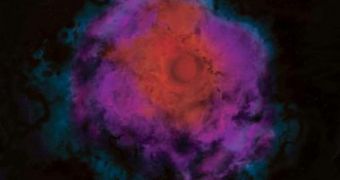Experts have recently come to believe that some of the earliest stars in the Universe, which formed more than 13 billion years ago, may have been fueled by dark matter originally. This type of matter was hypothesized more than a decade ago, but thus far scientists have been unable to detect it directly. But some believe that the first stars, those made of dark matter, may still be around today, and ready to be studied. However, they most likely shed no light, so identifying them could be a bit tricky.
According to scientific models, it may be that these peculiar space structures can be found inside very cold clouds of hydrogen gas. These clouds may also be emitting gamma rays, neutrinos and antimatter, forms of matter that are not normally associated with hydrogen agglomerations. The gigantic stars may be between 400 and 20,000 times wider than our own Sun, as well as 500 to 1,000 times more massive, Space reports. The clouds in which they are hypothesized to rest would be mostly made up of molecular hydrogen, experts believe.
In addition to explaining the early stages of stellar formation, as well as yielding more clues as to how to find dark matter, studying these formations could also help astrophysicists understand why black holes appeared and formed a lot faster than they should have. Experts calculate that the dark matter stars may have appeared as early as 80 to 100 million years after the Big Bang, and that they were most likely made up of clouds of molecular hydrogen and helium, only “fluffier” than our Sun is today. “It's a completely new type of star with a new power source,” University of Michigan theoretical physicist and researcher Katherine Freese says.
The main assumptions about dark matter stars hold that they are not powered by the nuclear fusion of hydrogen atoms into helium, but by dark matter itself. The latter is potentially made up of weakly-interacting massive particles (WIMP), but this idea is still unproven to date. Some say that the mass of actual dark matter in such a star would be very small, about 1 percent, but add that this is “very important. It converts all of its mass to energy with 100 percent efficiency, under Einstein's equation, E=mc2. Normal stars that rely on nuclear energy convert just a small fraction of its mass to energy, 1 or 2 percent,” says University of Utah particle astrophysicist Paolo Gondolo.
The discovery of dark matter stars “would tell us a very important thing – that dark matter is made of elementary particles. At this moment, we know absolutely nothing about what dark matter is made of. We know where dark matter is, how much is there, but we don't know its nature,” the expert adds.
“The ones that formed in the early universe could have continued as long as they had dark matter to power them. They start at the center of dark matter 'halos' – giant spherical globes of dark matter – and these are always merging with other ones, so some might have burned out their dark matter fuel very early and become either normal stars or collapsed, but it remains an open question if any have survived until now,” Freese reveals.

 14 DAY TRIAL //
14 DAY TRIAL //